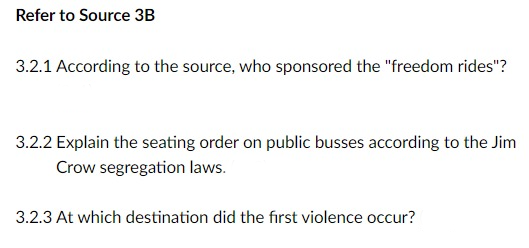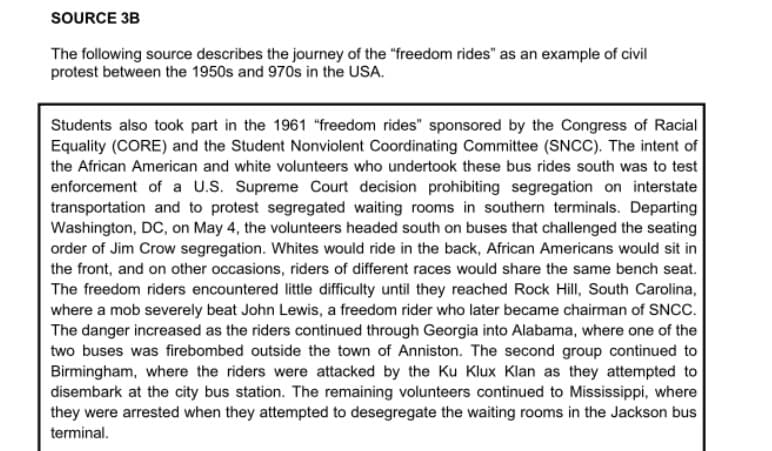3.2.1 According to the source, who sponsored the "freedom rides"? 3.2.2 Explain the seating order on public busses according to the Jim Crow segregation laws. 3.2.3 At which destination did the first violence occur?
3.2.1 According to the source, who sponsored the "freedom rides"? 3.2.2 Explain the seating order on public busses according to the Jim Crow segregation laws. 3.2.3 At which destination did the first violence occur?
Related questions
Question

Transcribed Image Text:Refer to Source 3B
3.2.1 According to the source, who sponsored the "freedom rides"?
3.2.2 Explain the seating order on public busses according to the Jim
Crow segregation laws.
3.2.3 At which destination did the first violence occur?

Transcribed Image Text:SOURCE 3B
The following source describes the journey of the "freedom rides" as an example of civil
protest between the 1950s and 970s in the USA.
Students also took part in the 1961 "freedom rides" sponsored by the Congress of Racial
Equality (CORE) and the Student Nonviolent Coordinating Committee (SNCC). The intent of
the African American and white volunteers who undertook these bus rides south was to test
enforcement of a U.S. Supreme Court decision prohibiting segregation on interstate
transportation and to protest segregated waiting rooms in southern terminals. Departing
Washington, DC, on May 4, the volunteers headed south on buses that challenged the seating
order of Jim Crow segregation. Whites would ride in the back, African Americans would sit in
the front, and on other occasions, riders of different races would share the same bench seat.
The freedom riders encountered little difficulty until they reached Rock Hill, South Carolina,
where a mob severely beat John Lewis, a freedom rider who later became chairman of SNCC.
The danger increased as the riders continued through Georgia into Alabama, where one of the
two buses was firebombed outside the town of Anniston. The second group continued to
Birmingham, where the riders were attacked by the Ku Klux Klan as they attempted to
disembark at the city bus station. The remaining volunteers continued to Mississippi, where
they were arrested when they attempted to desegregate the waiting rooms in the Jackson bus
terminal.
Expert Solution
This question has been solved!
Explore an expertly crafted, step-by-step solution for a thorough understanding of key concepts.
Step by step
Solved in 2 steps
